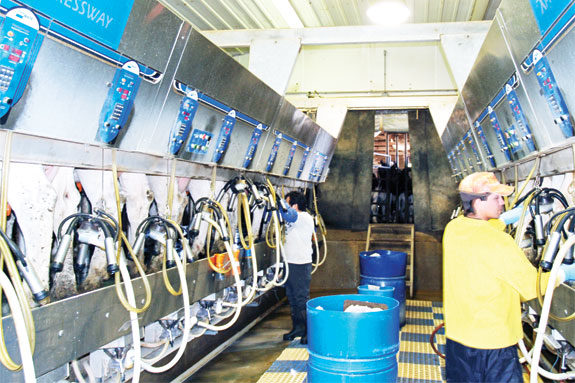A key factor for good milking is the hormone oxytocin. Oxytocin is responsible for milk letdown, and without oxytocin, cows will not be milked out completely or rapidly. Oxytocin is released into the blood in response to various stimuli, and causes contraction of the udder’s muscle cells. Milk is available for removal from the udder because of these contractions. The process of oxytocin release can start with stimulation of the teats, specifically the teat ends, as this is where most nerve receptors are located. The sound of the vacuum pump in the parlor, or even the act of walking to the parlor, can also be stimuli for oxytocin release. Milking procedures either contribute to or depend upon this release of oxytocin.
Another important component of milking procedure basics is that it is a good practice for milkers to wear disposable gloves. Gloves are easier to sanitize than hands, helping to prevent the spread of bacteria from cow to cow as well as helping protect milkers’ hands.
Step 1
Start by providing animals with a clean, low-stress environment. An animal that is fearful or stressed releases adrenaline. Adrenaline inhibits oxytocin release, and reduces the action of oxytocin in the mammary gland. Cows are creatures of habit and should be brought to the parlor in the same fashion at every milking. Refrain from yelling or sudden movements, and watch for overuse of crowd gates. Dogs in the parlor or alleyways may also elicit a fear response in cows. The next few steps address preparing the udder for milking. Variations in the milking process do not matter as long as the end results are clean, dry teats and the release of oxytocin.
Step 2
Stripping teats serves as an important stimulation for oxytocin release and also allows for clinical mastitis detection. Some cows will have mastitis and never show symptoms, but abnormal milk is a sign of infection. It’s important to remember that we want to strip the milk onto the floor, and never into paper towels or hands. If the milk is contaminated with bacteria, bacteria can easily spread from hands to other teats or animals.
Step 3
When applying sanitizing solution (pre-dip), the objectives are good coverage and proper contact time. Contact times vary with the product, so refer to the label. Ensure the teat ends are properly sanitized.
Step 4
The final step in the preparation process is to remove the pre-dip and dry the teats. To prevent the spread of mastitis-causing bacteria from one cow to another, always use a clean towel (paper or cloth) for each animal. Milking wet, dirty teats increases the standard plate and coliform counts in milk, both of which are indications of poor milk quality and milking parlor hygiene.
Step 5/6
To get the most out of milk letdown, attach milking units within 60 to 90 seconds after first stimulation for optimal oxytocin release. Remember, stimulation for milk letdown can begin when the cows enter the parlor or when the teats are stripped, so it is important to have a consistent routine. At this point, it’s important to properly align the milking unit under the cow when attaching the teat cups.
Step 7
When using automatic take-off machines, ensure they are adjusted properly to remove at low milk flow. If takeoff is done manually, always remember to shut off the vacuum prior to removing the milking unit.
Step 8
Dip or spray every teat after milking with an effective post-dip product, ensuring total coverage of teats. The teat ends are still open at this point, allowing easy access of bacteria into the udder. This post-application is her best defense against invading, mastitis-causing bacteria. It is also advisable to have fresh feed available to cows when they return to their pen after milking. Cows should stand for 30 to 60 minutes to allow the muscles surrounding the teat opening to close the teat end. It is important cows return to a clean environment, for example, clean, well-bedded freestalls. PD
— Excerpts from University of California Dairy Newsletter, Vol. 2, No. 5
Key points to remember:
• Keep milking pleasant for cows; procedures and milking equipment should allow for rapid milkout. Be sure the milking equipment is operating properly and liners are in proper condition. Be consistent with milking procedures, as cows are creatures of habit.
• If sprinkler pens are used, cows should be dry before entering the parlor. The goal is to always milk clean, dry cows that are properly stimulated.
• Keep a clean, low-stress environment!

-
Jennifer Heguy
- Dairy Farm Adviser
- UC Cooperatve Extension
- Email Jennifer Heguy






